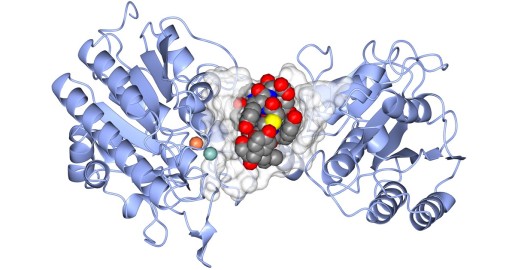04/11/2017 09:00 AM EDT

When you think of the causes of infectious diseases, what first comes to mind are probably viruses and bacteria. But parasites are another important source of devastating infection, especially in the developing world. Now, NIH researchers and their collaborators have discovered a new kind of treatment that holds promise for fighting parasitic roundworms. A bonus […]

Fighting Parasitic Infections: Promise in Cyclic Peptides

Caption: Cyclic peptide (middle) binds to iPGM (blue).
Credit: National Center for Advancing Translational Sciences, NIH
Credit: National Center for Advancing Translational Sciences, NIH
When you think of the causes of infectious diseases, what first comes to mind are probably viruses and bacteria. But parasites are another important source of devastating infection, especially in the developing world. Now, NIH researchers and their collaborators have discovered a new kind of treatment that holds promise for fighting parasitic roundworms. A bonus of this result is that this same treatment might work also for certain deadly kinds of bacteria.
The researchers identified the potential new therapeutic after testing more than a trillion small protein fragments, called cyclic peptides, to find one that could disable a vital enzyme in the disease-causing organisms, but leave similar enzymes in humans unscathed. Not only does this discovery raise hope for better treatments for many parasitic and bacterial diseases, it highlights the value of screening peptides in the search for ways to treat conditions that do not respond well—or have stopped responding—to more traditional chemical drug compounds.
Humans, parasites, and bacteria depend on the same cellular pathway to break down glucose for energy. This life-sustaining metabolic pathway includes essentially all of the same enzymes with one notable exception: cofactor-independent phosphoglycerate mutase (iPGM). This enzyme is found in parasites and bacteria, but not in people. Yes, we humans have an enzyme that does that same job—but it does so in a different way and is assembled from an entirely different sequence of amino acid building blocks.
Given this very exploitable difference, iPGM jumped several years ago to the top of the list as a drug target that would kill disease-causing parasites without harming people. Researchers soon began screening a chemical library and its more than 380,000 traditional drug candidates to find the right small-molecule inhibitor, the preferred compound in drug discovery.
All of their hard work came up empty. iPGM, unlike most enzymes, has two structural domains that quickly flap open and shut with the help of a hinge-like region running between them. Missing was the usual pocket-shaped active site, where a traditional small molecule can readily bind and block function. As promising a target as iPGM was, it appeared to be “undruggable.” [1]
Or was it? James Inglese, a researcher at NIH’s National Center for Advancing Translational Sciences, and his colleagues decided to take another look. This time, they turned to a different class of molecules called cyclic peptides in an attempt to disable iPGM. They thought the peptides, which have a larger surface area compared to traditional drug compounds, stood a better chance of binding to the enzyme surface and blocking its function.
As reported in Nature Communications, the team built a library including more than a trillion different ring-like peptides [2]. They then tested the ability of each and every one to bind to iPGM enzymes taken from various worms and a bacterium.
Out of a trillion-plus peptides, just two bound tightly and exclusively to iPGM. Those peptides, which the researchers named ipglycermides, are nearly identical structurally and act much like a door stop. That is, they hold the hinged enzyme locked in an open position that blocks its vital metabolic function.
In theory, these ipglycermides could become a treatment with the ability to fight the parasitic roundworms that infect tens of millions of people. Such a drug could also help to fight antibiotic-resistant strains of Staphylococcus aureus, a bacterium that is a common-cause of hospital-acquired infections, and Bacillus anthracis, a bacterium that causes anthrax.
Now the researchers know what it takes to block iPGM function. But they also need to work on how to deliver the peptide to the right place inside cells. Before testing their peptides in animal models, they’ll continue to tinker with them in search of a version effective in disabling iPGM that might also make its way into cells more easily.
Drug development is a notoriously long and arduous process, which too often ends in disappointment. But this research is a reminder that targets deemed undruggable today could be well within reach tomorrow. Let’s hope in the future we’ll be reading about—and benefiting from—many more finds like this one.
References:
[1] Cofactor-independent phosphoglycerate mutase from nematodes has limited druggability, as revealed by two high-throughput screens. Crowther GJ, Booker ML, He M, Li T, Raverdy S, Novelli JF, He P, Dale NR, Fife AM, Barker RH Jr, Kramer ML, Van Voorhis WC, Carlow CK, Wang MW. PLoS Negl Trop Dis. 2014 Jan 9;8(1):e2628.
[2] Macrocycle peptides delineate locked-open inhibition mechanism for microorganism phosphoglycerate mutases. Yu H, Dranchak P, Li Z, MacArthur R, Munson MS, Mehzabeen N, Baird NJ, Battalie KP, Ross D, Lovell S, Carlow CK, Suga H, Inglese J. Nat Commun. 2017 Apr 3;8:14932.
Links:
Parasitic Diseases (Medline Plus, National Library of Medicine/NIH)
Improving the Drug Development Process (National Center for Advancing Translational Sciences/NIH)
James Inglese (National Center for Advancing Translational Sciences/NIH)
NIH Support: National Center for Advancing Translational Sciences; National Heart, Lung, and Blood Institute; National Institute of General Medical Sciences





















.jpg)












No hay comentarios:
Publicar un comentario